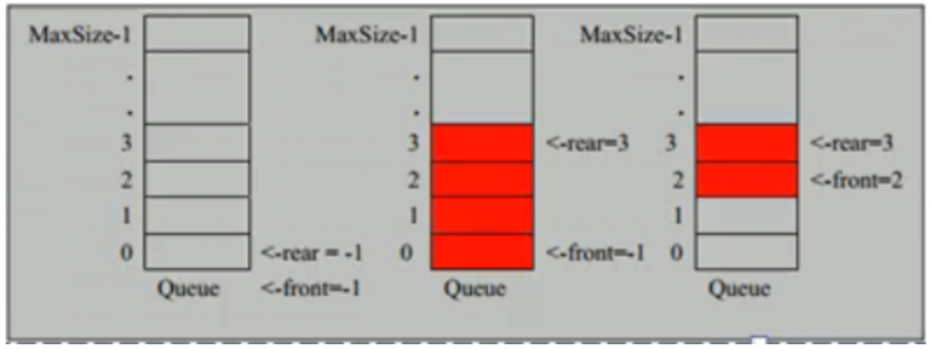Java編程內(nèi)功-數(shù)據(jù)結(jié)構(gòu)與算法「隊(duì)列」
基本介紹
隊(duì)列是一個有序列表,可以用數(shù)組或者鏈表來實(shí)現(xiàn)
遵循先入先出的原則,即先存入隊(duì)列的數(shù)據(jù),要先取出.后存入的要后取出
數(shù)組模擬隊(duì)列
隊(duì)列本身是有序列表,若使用數(shù)組的結(jié)構(gòu)來存儲隊(duì)列的數(shù)據(jù),則隊(duì)列數(shù)組的聲明如下圖,其中maxSize是該隊(duì)列的最大容量.
因?yàn)殛?duì)列的輸入\輸出是分別從前后端來處理,因此需要兩個變量front及rear分別記錄隊(duì)列前后端的下標(biāo),front會隨著數(shù)據(jù)輸出而改變,而rear則是隨著數(shù)據(jù)輸入而改變.

代碼案例
- package com.structures.queue;
- import java.util.Scanner;
- public class ArrayQueueDemo {
- public static void main(String[] args) {
- ArrayQueue arrayQueue = new ArrayQueue(3);
- char key = ' ';//接受用戶輸入
- Scanner scanner = new Scanner(System.in);
- boolean loop = true;
- //輸出一個菜單
- while (loop) {
- System.out.println("s(show):顯示隊(duì)列");
- System.out.println("e(exit):退出程序");
- System.out.println("a(add):添加數(shù)據(jù)到隊(duì)列");
- System.out.println("g(get):從隊(duì)列取出數(shù)據(jù)");
- System.out.println("h(head):查看隊(duì)列頭的數(shù)據(jù)");
- key = scanner.next().charAt(0);
- switch (key) {
- case 's':
- arrayQueue.showQueue();
- break;
- case 'a':
- System.out.println("輸入一個整數(shù)");
- int value = scanner.nextInt();
- arrayQueue.addQueue(value);
- break;
- case 'g':
- try {
- int queue = arrayQueue.getQueue();
- System.out.printf("取出的數(shù)據(jù)是%d", queue);
- }catch (Exception e){
- System.out.println(e.getMessage());
- }
- break;
- case 'e':
- scanner.close();
- loop = false;
- break;
- case 'h':
- try {
- int head = arrayQueue.headQueue();
- System.out.printf("取出隊(duì)列頭的數(shù)據(jù)是%d", head);
- }catch (Exception e){
- System.out.println(e.getMessage());
- }
- default:
- break;
- }
- }
- System.out.println("程序退出");
- }
- }
- //使用數(shù)組模擬隊(duì)列-編寫一個ArrayQueue類
- class ArrayQueue {
- //表示數(shù)組最大容量
- private int maxSize;
- //隊(duì)列頭
- private int front;
- //隊(duì)列尾
- private int rear;
- //用于存放數(shù)據(jù),模擬隊(duì)列
- private int[] arr;
- //創(chuàng)建隊(duì)列構(gòu)造器
- public ArrayQueue(int arrMaxSize) {
- maxSize = arrMaxSize;
- arr = new int[maxSize];
- front = -1;//指向隊(duì)列頭的前一個位置
- rear = -1;//指向隊(duì)列尾的數(shù)據(jù),即就是隊(duì)列最后一個數(shù)據(jù)
- }
- //判斷隊(duì)列是否滿
- public boolean isFull() {
- return rear == maxSize - 1;
- }
- //判斷隊(duì)列是否為空
- public boolean isEmpty() {
- return rear == front;
- }
- //添加數(shù)據(jù)到隊(duì)列
- public void addQueue(int n) {
- if (isFull()) {
- System.out.println("隊(duì)列不能加入數(shù)據(jù)");
- return;
- }
- rear++;//讓rear 后移
- arr[rear] = n;
- }
- //獲取隊(duì)列數(shù)據(jù),出隊(duì)列
- public int getQueue() {
- if (isEmpty()) {
- throw new RuntimeException("隊(duì)列為空,不能取數(shù)據(jù)");
- }
- front++;
- return arr[front];
- }
- //顯示隊(duì)列所有數(shù)據(jù)
- public void showQueue() {
- if (isEmpty()) {
- System.out.println("隊(duì)列為空,沒有數(shù)據(jù)");
- }
- for (int i = 0; i < this.arr.length; i++) {
- System.out.printf("arr[%d]=%d\n", i, arr[i]);
- }
- }
- //顯示隊(duì)列的頭數(shù)據(jù),注意不是取數(shù)據(jù)
- public int headQueue() {
- if (isEmpty()) {
- throw new RuntimeException("隊(duì)列為空,沒有數(shù)據(jù)");
- }
- return arr[front + 1];
- }
- }
問題分析
- 目前這個數(shù)組使用一次就不能用,沒有達(dá)到復(fù)用的效果.
- 將這個數(shù)組使用算法,改進(jìn)成一個環(huán)形的隊(duì)列:取模%
改進(jìn)成環(huán)形隊(duì)列的思路分析
- front變量的含義做一個調(diào)整:front 就指向隊(duì)列的第一個元素,也就是arr[front]就是隊(duì)列的第一個元素,front的初始值=0
- rear變量的含義做一個調(diào)整:rear 指向隊(duì)列的最后一個元素的后一個位置,因?yàn)橄M粘鲆粋€空間作為約定.rear初始值=0
- 當(dāng)隊(duì)列滿時,條件是(rear+1)%maxSize = front.
- 當(dāng)隊(duì)列為空時條件,rear == front 空.
- 當(dāng)我們這樣分析,隊(duì)列中有效的數(shù)據(jù)的個數(shù)=(rear+maxSize-front)%maxSize.
環(huán)形隊(duì)列代碼案例
- package com.structures.queue;
- import java.util.Scanner;
- public class CircleArrayQueue {
- public static void main(String[] args) {
- CircleArray arrayQueue = new CircleArray(4);//這里設(shè)置4,其隊(duì)列的有效數(shù)據(jù)最大是3
- char key = ' ';//接受用戶輸入
- Scanner scanner = new Scanner(System.in);
- boolean loop = true;
- //輸出一個菜單
- while (loop) {
- System.out.println("s(show):顯示隊(duì)列");
- System.out.println("e(exit):退出程序");
- System.out.println("a(add):添加數(shù)據(jù)到隊(duì)列");
- System.out.println("g(get):從隊(duì)列取出數(shù)據(jù)");
- System.out.println("h(head):查看隊(duì)列頭的數(shù)據(jù)");
- key = scanner.next().charAt(0);
- switch (key) {
- case 's':
- arrayQueue.showQueue();
- break;
- case 'a':
- System.out.println("輸入一個整數(shù)");
- int value = scanner.nextInt();
- arrayQueue.addQueue(value);
- break;
- case 'g':
- try {
- int queue = arrayQueue.getQueue();
- System.out.printf("取出的數(shù)據(jù)是%d", queue);
- }catch (Exception e){
- System.out.println(e.getMessage());
- }
- break;
- case 'e':
- scanner.close();
- loop = false;
- break;
- case 'h':
- try {
- int head = arrayQueue.headQueue();
- System.out.printf("取出隊(duì)列頭的數(shù)據(jù)是%d", head);
- }catch (Exception e){
- System.out.println(e.getMessage());
- }
- default:
- break;
- }
- }
- System.out.println("程序退出");
- }
- }
- class CircleArray {
- //表示數(shù)組最大容量
- private int maxSize;
- //front變量的含義做一個調(diào)整:front 就指向隊(duì)列的第一個元素,也就是arr[front]就是隊(duì)列的第一個元素,front的初始值=0
- private int front;
- //rear變量的含義做一個調(diào)整:rear 指向隊(duì)列的最后一個元素的后一個位置,因?yàn)橄M粘鲆粋€空間作為約定.rear初始值=0
- private int rear;
- //用于存放數(shù)據(jù),模擬隊(duì)列
- private int[] arr;
- public CircleArray(int arrMaxSize) {
- maxSize = arrMaxSize;
- arr = new int[maxSize];
- }
- //判斷隊(duì)列是否滿
- public boolean isFull() {
- return (rear + 1) % maxSize == front;
- }
- //判斷隊(duì)列是否為空
- public boolean isEmpty() {
- return rear == front;
- }
- //添加數(shù)據(jù)到隊(duì)列
- public void addQueue(int n) {
- if (isFull()) {
- System.out.println("隊(duì)列滿,隊(duì)列不能加入數(shù)據(jù)");
- return;
- }
- //直接將數(shù)據(jù)加入
- arr[rear] = n;
- //將rear后移,這里必須考慮取模
- rear = (rear + 1) % maxSize;
- }
- //獲取隊(duì)列數(shù)據(jù),出隊(duì)列
- public int getQueue() {
- if (isEmpty()) {
- throw new RuntimeException("隊(duì)列為空,不能取數(shù)據(jù)");
- }
- //這里需要分析front是指向隊(duì)列的第一個元素,
- //1.先把front對應(yīng)的值保存到一個臨時變量,
- //2.將front后移,考慮取模
- //3.將臨時保存的變量返回
- int value = arr[front];
- front = (front + 1) % maxSize;
- return value;
- }
- //顯示隊(duì)列所有數(shù)據(jù)
- public void showQueue() {
- if (isEmpty()) {
- System.out.println("隊(duì)列為空,沒有數(shù)據(jù)");
- }
- //從front開始遍歷
- for (int i = front; i < front + size(); i++) {
- System.out.printf("arr[%d]=%d\n", i % maxSize, arr[i % maxSize]);
- }
- }
- //求出當(dāng)前隊(duì)列有效數(shù)據(jù)的個數(shù)
- public int size() {
- return (rear + maxSize - front) % maxSize;
- }
- //顯示隊(duì)列的頭數(shù)據(jù),注意不是取數(shù)據(jù)
- public int headQueue() {
- if (isEmpty()) {
- throw new RuntimeException("隊(duì)列為空,沒有數(shù)據(jù)");
- }
- return arr[front];
- }
- }
【編輯推薦】


























